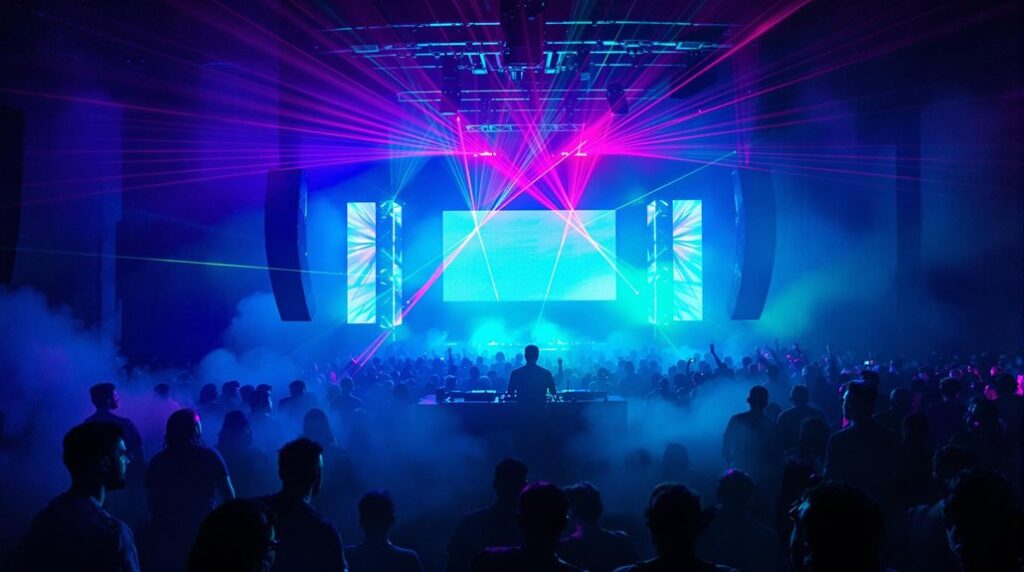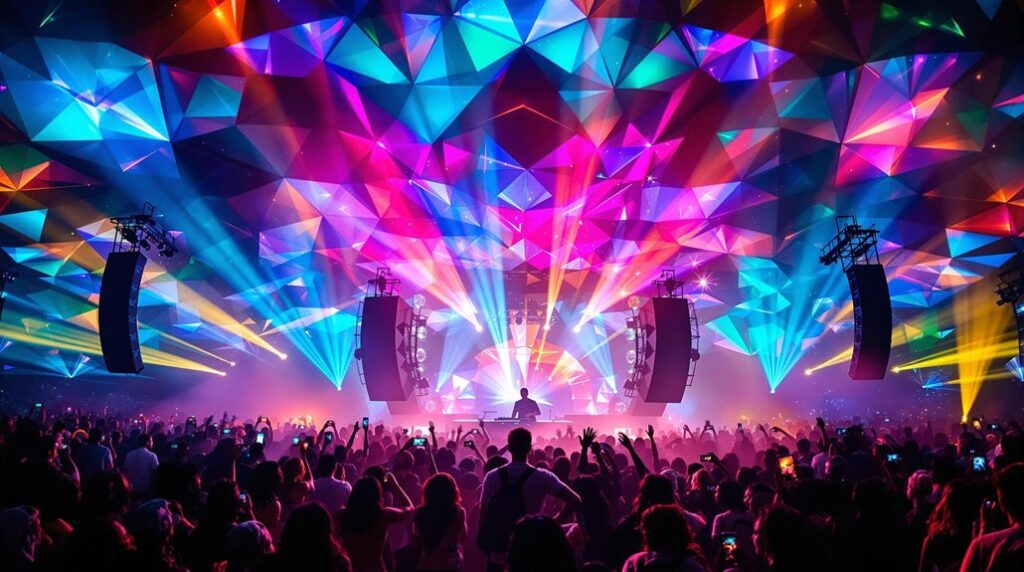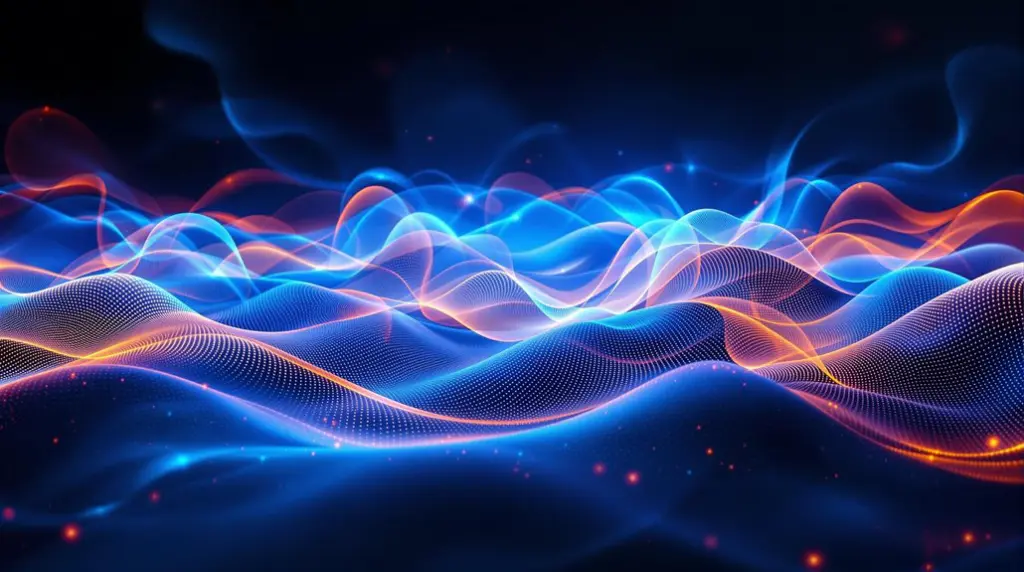You’ve witnessed the pivotal transformations in EDM, from the late 1970s synth-based disco revolution led by Giorgio Moroder to Kraftwerk‘s trailblazing use of synthesizers and drum machines. House music then took its roots in Chicago’s vibrant atmosphere, enriching the world with its unique blend of disco, soul, and funk. In Detroit, techno emerged, reflecting the city’s post-industrial ethos with powerful basslines and futuristic melodies. Trance music rolled out from Germany, bringing its hypnotic rhythms to the global stage. The explosive rise of dubstep from South London introduced intricate basslines and rhythms, profoundly shaping contemporary sounds. Consider how deeper insights into each milestone could further enhance your understanding of EDM’s remarkable evolution.
Key Takeaways
- Giorgio Moroder’s integration of synthesizers in disco during the late 1970s catalyzed the evolution of electronic dance music.
- Kraftwerk’s 1974 album ‘Autobahn’ pioneered the use of electronic instruments, influencing myriad EDM genres.
- The genesis of house music in early 1980s Chicago, merging disco, soul, and funk, revolutionized dance music globally.
- Detroit’s techno movement in the 1980s, driven by artists like Derrick May, mirrored the city’s industrial ethos with its innovative sound.
- The rise of global EDM festivals such as Tomorrowland and Ultra Music Festival, showcasing the genre’s vast appeal and diversity.
The Birth of Synth-based Disco
In the late 1970s, the emergence of synth-based disco revolutionized dance music by integrating synthesized rhythms and electronic instruments into the disco scene. This era marked a significant turning point, where you can see the tangible effects of synth innovation on mainstream music. Artists like Giorgio Moroder, who masterfully crafted the soundtrack of Donna Summer’s ‘I Feel Love,’ were pivotal. They didn’t just use the synthesizer; they turned it into the star of the show, creating layers of sound that were unheard of in earlier disco music.
This disco fusion wasn’t just a blip on the radar. It was the foundation of what would become a sweeping electronic evolution in dance music. By weaving synthetic textures with traditional disco beats, these pioneers propelled the dance revolution forward, influencing countless genres and artists that followed. The impact of these synth-based tracks was profound, setting the stage for electronic dance music as a dominant force in the following decades. Each thumping bassline and ethereal synth sweep in clubs across the globe can trace its roots back to this transformative period. You’re hearing not just music but the echo of a revolution.
Kraftwerk’s Electronic Revolution
As you explore Kraftwerk’s monumental role in the evolution of electronic dance music, it’s essential to recognize their groundbreaking use of synthesizers during the 1970s.
Their seminal album ‘Autobahn‘ not only introduced a new sonic palette but also set a global standard, influencing myriad genres from techno to hip-hop.
This expansion of their influence marked a pivotal shift, establishing electronic music as a dominant force in the global music scene.
Kraftwerk’s Synth Pioneering
Kraftwerk revolutionized electronic music in the 1970s by pioneering the use of synthesizers and drum machines, setting the stage for the genres that would follow. As synth pioneers, their innovation impact is undeniable, fundamentally altering electronic music evolution with groundbreaking contributions.
Imagine the new sonic landscapes they introduced:
- Whirring Synthesizers: Crafting layered textures that felt futuristic yet intimately human.
- Mechanical Drum Machines: Pulsing beats that provided a stark, rhythmic backbone to their synthetic melodies.
- Harmonic Experimentation: Merging traditional harmonies with electronic timbres to create a completely new auditory experience.
Their experimental approach not only pushed technological boundaries but also laid the groundwork for the diverse spectrum of electronic music genres we enjoy today.
Global Influence Expansion
Building on their pioneering work with synthesizers, Kraftwerk’s influence rapidly expanded beyond the music scene, reshaping global culture across various mediums. Their albums like ‘Autobahn‘ and ‘Trans-Europe Express‘ didn’t just play; they echoed through the corridors of global music, inspiring a cultural fusion unlike any before.
You can trace their electronic signatures in genres from hip-hop to techno, where their synthetic rhythms and robotic aesthetics have become foundational. Beyond tunes, their avant-garde approach influenced visual arts, fashion, and even technology, melding with diverse cultural elements to broaden their global impact.
Today, Kraftwerk isn’t just a band; they’re a phenomenon that redefined not only music but also the very fabric of cultural expression in the electronic age.
The Rise of House Music
As you explore the origins of house music, you’ll find it emerged from Chicago’s vibrant club scene in the early 1980s, synthesizing disco’s rhythm with electronic sounds to create something entirely new.
You’ll also discover key artists like Frankie Knuckles and Jesse Saunders, who not only pioneered the genre but also influenced the texture of global dance music.
Origins of House Music
House music, emerging in Chicago during the early 1980s, fused disco, soul, and funk to create a vibrant new dance genre. Its Chicago roots are deeply intertwined with the underground influence of local clubs and DJs. Here’s what you need to visualize:
- Dimly lit clubs filled with the raw energy of non-stop, pulsating beats.
- Eclectic crowds, united by the rhythmic throb of deep bass and synthesizers.
- Innovative DJs spinning records that defined a cultural movement.
This genre quickly transcended its local boundaries, capturing the imagination of audiences worldwide. Its repetitive 4/4 beats and soulful vocals weren’t just music; they became the heartbeat of a new cultural phenomenon in dance music.
Key House Music Artists
While exploring the vibrant landscape of house music, it’s impossible to ignore the pioneering artists like Frankie Knuckles and Marshall Jefferson, whose creative genius propelled this genre onto the global stage.
As house music innovators, they played pivotal roles in the genre evolution, shaping not just a collection of impactful house tracks but the very framework of electronic music itself.
Their influence extended beyond Chicago, fostering a global movement that saw the rise of various subgenres. This diversification enriched the electronic music landscape, inviting more creativity and innovation.
Through their groundbreaking work, house music became a seminal force in the dance music scene, laying the groundwork for the next generations of artists.
Iconic House Tracks
Numerous iconic tracks have defined the rise of house music, each marking significant moments in the genre’s expansion from Chicago’s underground clubs to global acclaim. As you explore the history, you’ll recognize how certain house classics became emblematic of genre evolution.
- ‘Your Love’ by Frankie Knuckles: Often dubbed the Godfather of House, Knuckles’ track is a cornerstone, blending soulful melodies with synthesizer-based choruses that resonated worldwide.
- ‘French Kiss’ by Lil Louis: This track is notable for its slow-building dynamics and orgasmic breakdowns, which helped bridge house music to mainstream audiences.
- ‘Can You Feel It’ by Larry Heard: A quintessential deep house track that encapsulates the genre’s ability to evoke deep emotional responses through minimalist yet powerful compositions.
Techno Emerges in Detroit
In the 1980s, Detroit became the birthplace of techno, a genre shaped by its industrial backdrop and the innovative spirit of artists like Derrick May and Juan Atkins. This era marked a pivotal moment where Detroit innovation and electronic experimentation fused, creating a sound that resonated with the city’s mechanical pulse. As you explore further into this genre’s origins, you’ll notice how Detroit’s economic and cultural landscapes influenced its development.
The techno that originated in Detroit wasn’t just electronic music; it was a revolutionary response to the urban environment. Artists like May and Atkins didn’t simply craft tracks; they sculpted sonic landscapes that mirrored the city’s post-industrial vibe. Their music featured driving basslines and futuristic synth melodies, elements that became hallmarks of the genre. This wasn’t just about beats; it was about creating an auditory experience that encapsulated the essence of a transforming city.
Furthermore, the repetitive percussion and rhythmic patterns in Detroit techno didn’t just make people move; they made people feel part of something larger than themselves. This was the sound of a new generation, a sound that would lay the groundwork for numerous future trends in electronic dance music, proving that from industrial decay could come artistic innovation.
Trance and Its Psychedelic Impact
Emerging from Germany in the early 1990s, trance music quickly captivated audiences with its hypnotic beats and melodic intricacies. As you explore its evolutionary journey, you’ll uncover how trance carved a niche in the global EDM scene, creating a euphoric and uplifting atmosphere that resonates at a BPM range of 125-150. This genre isn’t just about the music; it’s a full sensory experience, heavily intertwined with psychedelic visuals that enhance the listener’s experience.
Trance festivals, such as A State of Trance (ASOT), have become pivotal in popularizing this genre, drawing thousands of fans worldwide. Here’s what you’ll often witness at these gatherings:
- Massive stages: Set against the backdrop of surreal, psychedelic visuals, these are where DJs like Armin van Buuren and Above & Beyond captivate the crowd.
- Light shows: Synched perfectly with the beats, the light shows create mesmerizing patterns that pulse with the rhythm of trance.
- Engaged crowds: Fans, often in a trance-like state, dance with a collective energy that’s both intense and harmonious.
Understanding the impact of trance and its psychedelic influence, you’ll appreciate how it’s more than music; it’s a cultural phenomenon that continues to evolve and inspire.
Dubstep and Bass Music Explosion
As dubstep burst onto the South London scene in the early 2000s, it revolutionized electronic dance music with its profound basslines and intricate rhythms. Pioneered by artists like Skream, Benga, and Coki, dubstep’s initial sound was deeply rooted in the urban vibes of garage and drum and bass, representing a significant phase in bassline evolution. This genre’s hallmark was its emphasis on staggered, syncopated beats combined with overwhelmingly powerful bass.
Dubstep’s influence rapidly transcended its underground origins, propelling into international popularity by the late 2000s. When Skrillex released ‘Scary Monsters and Nice Sprites‘, the global music scene was taken by storm, showcasing how dubstep elements could be melded with different musical styles. This era marked a pivotal moment for genre fusion, as even mainstream pop artists like Katy Perry and Britney Spears began weaving dubstep’s gritty textures into their chart-topping hits.
Moreover, the explosive growth of dubstep paved the way for the emergence of subgenres such as brostep, future bass, and trap music. Each of these genres borrowed the foundational elements of dubstep but pushed the boundaries through sonic experimentation and future innovations, continually reshaping the landscape of electronic dance music.
EDM’s Global Festival Culture
The explosive growth of dubstep not only transformed music studios but also reshaped festival stages worldwide, ushering in a new era of EDM’s global festival culture. This cultural phenomenon is marked by festival innovation and musical diversity, creating a unique community connection among attendees from various backgrounds.
Consider these major festivals that epitomize the spirit of EDM’s global reach:
- Electric Daisy Carnival (EDC): With over 400,000 attendees each year, EDC stands as a beacon of festival innovation. Its elaborate stages and immersive experiences are a reflection of the creative spirit of EDM culture.
- Tomorrowland: Held in Belgium, Tomorrowland is more than just a music festival; it’s a vibrant cultural exchange hub. The festival’s ability to draw people from all corners of the globe highlights its role in fostering global connections through the love of EDM.
- Ultra Music Festival: Located in Miami, this festival attracts over 165,000 fans annually and showcases a wide array of EDM talents, promoting musical diversity and setting trends within the genre.
These festivals aren’t just events; they’re cultural phenomena that illustrate the dynamic ways in which EDM continues to influence global music scenes and encourage cultural exchanges. Each festival, with its unique atmosphere and diverse lineup, contributes greatly to the fabric of global EDM festival culture.
Frequently Asked Questions
How Has EDM Changed Over Time?
EDM’s evolution reflects technological advancements and shifting cultural trends. You’ve seen artist collaborations transcend genres and festival impacts broaden audiences, fundamentally shifting its production and global reception over the decades.
What Was the Golden Age of Edm?
The golden age of EDM, spanning the late 1990s to early 2000s, featured groundbreaking festival influences and charismatic DJ personalities like Tiësto and Daft Punk, revolutionizing performances and mainstream music culture.
What Did EDM Evolve From?
EDM evolved from disco and techno, among other influences. Its disco roots shaped its early beats while techno’s influence brought a sharper, more electronic sound that defined its evolution throughout the years.
When Was the Peak of Electronic Music?
The peak of electronic music was in the 1990s, driven by festival impacts and artist collaborations that expanded its reach and innovation, shaping a vibrant, globally influential scene.
Conclusion
You’ve journeyed through the transformative milestones of the EDM genre, from the synth-infused disco origins to the global festival culture that unites millions.
Each phase, whether it’s Kraftwerk’s pioneering electronics or the gritty innovation of Detroit techno, has intricately woven a richer tapestry for EDM.
As you’ve seen, these evolutions aren’t just changes in sound but are cultural shifts, reflecting and influencing societal moods and movements.
Understanding these milestones provides deeper insight into the genre’s profound global impact.




